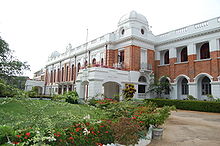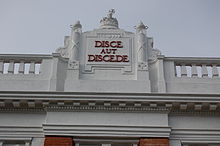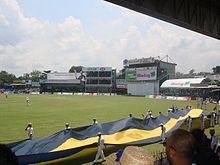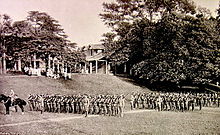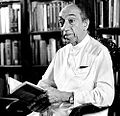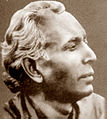- Royal College, Colombo
-
Coordinates: 6°54′16″N 79°51′40″E / 6.90444°N 79.86111°E
Royal College Colombo 
Location Colombo
Sri LankaInformation Type Public Established 1835 Founder Sir Robert Wilmot-Horton, 3rd Baronet Principal Upali Gunasekara Grades Class 1 - 13 Gender Boys Age 6 to 19 Enrollment 8000 Colour(s) Blue and gold Publication Royal College Magazine,
The RoyalistFormer pupils Old Royalists Website www.royalcollege.lk The Royal College of Colombo (commonly known as Royal College or simply as Royal) (Sinhala: කොළඹ රාජකීය මහා විද්යාලය) was founded in January 1835 in Colombo. Only college with official permission to use the Royal prefix in Sri Lanka is The Prestigious Royal College Colombo.It is considered to be the leading Public School in Sri Lanka.[1] The oldest public school in the country,[2] it is a selective entry National School, as such it is funded by the central government as opposed to the provincial council providing both primary and secondary education. Royal College is often referred to as the Eton of Sri Lanka[3] and it was selected as one of best innovative colleges in the world by Microsoft in 2009.[4]
Royal College has produced many distinguished alumni, including Presidents of two countries,[5] a Sultan,[6] and three Prime Ministers.[5]
Overview
Situated in a quiet residential suburb of Colombo known as the Cinnamon Gardens (Sinhala:කුරුඳු වත්ත) , it occupies an area of 34 acres (140,000 m2) along the Rajakeeya Mawatha (Sinhala: Royal Avenue or Royal Mawatha), boarded by Reid Avenue to the east; Thurstan College on Thurstan Road to the west and to the south its former premises which houses the University of Colombo. The college is funded by the Ministry of Education, which appoints its Principal. The Principal is the head of the administration of the College and is assisted by a Vice Principal. The school is divided in to three sections: the primary school (the former Royal College Preparatory School), middle school and the upper school, each coming under a deputy principal (the head of the primary school is known as the Headmaster/Headmistress). The college educates close to 9100 students in both secondary and primary education. Administration of the college hostel is carried out by the Warden under supervision of the Principal and is assisted by a Sub-warden.
History
The school was founded by the Rev. Joseph Marsh, the acting Colonial Chaplain at St. Paul's Church as the Hill Street Academy in 1835, as a private institution with 20 students, mainly from the upper class community situated at Hill Street, Pettah. In 1836, Sir Robert Wilmot-Horton, the British Governor of Ceylon, based on the recommendations of the Colebrooke Commission converted it, as the Colombo Academy,[7] into an English public school modeled on Eton College, with Marsh continuing as Head master. The oldest public school on the island with the governor as its patron, it gave to the children of leading Ceylonese an education which would make them fit to be citizens of the British Empire and serve as the principal public school and a model for other government schools that were to be built in Ceylon.[8] In 1836 the school was moved to San Sebastian Hill, Pettah, (prior to which it was at Maradana, next to Hulftsdorp) it would stay there for another 75 years before being shifted to Thurstan Road. Even though the college had close ties to Anglicanism at its early years, since 1936 it has remained a secular school. In 1859 it was renamed Colombo Academy and Queens College and affiliated to the University of Calcutta. In 1865 the Morgan Committee of inquiry into education recommended that it be reorganized and that scholarships should be awarded to study in University of Oxford.[7] It became the Colombo Academy once again in 1869.
In 1881 it was renamed Royal College Colombo with the royal consent from Her Majesty Queen Victoria. The Gazette Notification giving Her Majesty's approval to change the name of the school appeared on July 31, 1881. The same year the first cadet battalion in Ceylon was formed at the College, attached to the Ceylon Light Infantry. The Royal College Union was formed in 1891 as the first alumni society in the country.
On August 27, 1913 the school was moved to its new building at Thurstan Road (which is now the main building of the University of Colombo).[9] Ten years later on October 10, 1923 the school moved once again, this time to the newly built Victorian styled building on Reid Avenue, which it still occupies. This move was due to the suggestion made by a higher education committee in 1914, which suggested that Royal College should be converted into a University College. Due to the objections made by members of the Royal College Old Boys Union, especially by the speeches made by Frederick Dornhorst, KC, the then Governor of Ceylon, Lord Chalmers instead created a separate University College named University College Colombo, at the schools former premises which became the University of Colombo in the later years. With the introduction of free education in Ceylon in 1931, Royal stopped charging fees from its students thus proving education free of charge to this day.
In 1940 the school was again on the move this time due to the onset of World War II. The school was ordered to move out and the British Army moved in establishing a military hospital in the school buildings. Principal E.L. Bradby made sure the education of the students was carried on unhindered by moving the students in to four private villas (known as bungalows in Ceylon) at Turret Street, Colombo and shifting the 1-3 forms to Glendale bungalow in Bandarawela where it was till 1948. After the war the school was relocated to its old home on Ried Avenue, Colombo. In August 1977 the Royal Preparatory School was amalgamated to Royal College forming the school's primary school, with it came the county's only national theatre at the time the Navarangahala.
Five years earlier on May 22, 1972 the members of the House of Representatives of the Dominion of Ceylon met at the Royal Primary School Hall (Navarangahala) enacted the Republican Constitution that established the Republic of Sri Lanka.[10]
Current status
Since its establishment the main medium of education had been English; however with Sinhala becoming the official language along with Tamil, the medium of education was changed to Sinhala and Tamil. Since 2002 English has been reintroduced as a medium of education at the College. Students may select one of the three mediums in which to conduct their studies.
The school is equipped with facilities such as lecture halls, science and computer laboratories, auditoriums etc. This includes the 'College Hall' and the Navarangahala which is a national theatre.
The first hostel of the Colombo Academy was established in San Sebastian in 1868, establishing Royal as one of the first boarding schools in Sri Lanka. Since then the school has maintained a hostel for students from outside Colombo, with around 230 hostelers.
Sport plays a major part in Royal College's activities. The school's facilities include a swimming pool,[11] cricket and athletics grounds, tennis courts, indoor cricket nets and an international standard sports complex with its own rugby ground. The sports complex, built in 2000, a short distance from the college, hosts national and school sporting events all year round.
Admission to the school is very competitive. It gets its highest number of applications for admission to grade 1 and the best 250 students from all over the country enter the school in year 5 via the grade 5 scholarship examination.[12]
College tradition
The College motto is "Disce aut Discede", meaning "Learn or Depart" in Latin. The motto is associated with the high academic standard maintained at the school for over hundred and seventy five years. First mentions of the motto appearer during the tenure of Principal George Todd (1871–1878). "Floreat", meaning "Flourish" also in Latin has been a motto associated with school since the founding of the Colombo Academy in 1836. Derived from "Floreat Etona", the motto of Eton College on which the academy was modeled on at its formation. Although the school had affiliations with the Anglican Church, it is a secular school with students of all faiths admitted.
College song
Main article: School of Our FathersThe College song is "School of Our Fathers", which is sung at the start of the school day and on important occasions. The words of the song were written by Major H.L.Reed, a Principal of the school in 1927. The music was later revised by S. Schmid.
In 1968, a shorter version of the college song in Sinhala was composed on the instructions of the Principal by the same combination which composed the first song (Messrs W.A. Wickramasena and S.J.F. Dissanayake). It is sung at the end of the school day.
Houses
The students are divided into five houses. Formally four houses were established in 1918 by Principal Hartley with the names Cinnamon Gardens, Bambalapitiya North and South and Colpetty. They were renamed in 1921 with names are derived from past headmasters and principals of the college by Principal Major H. L Reed. In 1970 the fifth house was established in memory of Principal Reed. The houses are led by House Captains, competing in all major games to win the inter-house games and house colours are awarded winners. The houses are:
- Hartley House
- Colours :Pink & Blue
- Established :1918
- Harward House
- Colours :Pink & Grey
- Established :1918
- Marsh House
- Colours :Pink & Brown
- Established :1918
- Boake House
- Colours :Red & Black
- Established :1918
- Reed House
- Colours :Red & White
- Established :1970
Awards
There are 165 endowed prizes and awards. The College Main Hall carries the names of those students who have won the Panel Prizes. The most coveted prize at Royal is the Dornhorst Memorial Prize, awarded (since 1930) to the most popular student each year, in the memory of Frederick Dornhorst, KC, followed by the Lalith Athulathmudali Memorial Prize for the most outstanding Royalist of the year. The Turnour Prize awarded since 1846 is the oldest of the panel prizes. Prizes are awarded at the prize-giving under the patronage of the President of Sri Lanka (earlier under the patronage of the Governor of Ceylon).
The Royal Crown, is the most prestigious award a sportsman can achieve at Royal, awarded each year at the Colours Night to a sportsman who has made outstanding achievements in his field of sports while Colours are awarded to other players who have made significant contributions in the sporting arena.
Scholarship and Prizes
Prize Year of Institution Turnour Prize 1846 - Senior Mathematical Prize 1846–1934 Shakespeare Prize 1870–1932 English University Scholarship 1870–1926 Lorensz Scholarship 1876 Director's Prize 1883–1921 De Soysa Science Prize 1893 Sir James Peiris Memorial Prize 1905 Donald Obeyesekere Prize 1912 F Dadabhoy Memorial Prize 1922 The Governor's Prize 1922–1947 C M Fernando Memorial Prize 1925 Harward Memorial Prize 1926–1963 Steward's Prize 1929 Dornhorst Memorial Prize 1930 Gate Mudaliar R E Gooneratne Memorial Prize 1933 G L Rupasinghe Memorial Prize 1934 Dr F E Weerasooriya Memorial Prize 1934 Canon Lucien Jansz Memorial Prize 1934 Adigar A Sellamuttu Prize 1935 Ruby Andries Memorial Prize 1935 Stubbs Prize 1935–1970 Sir Edward Denham Memorial Prize 1939 Dr C A Hewavitarane Memorial Prize 1942 Cecil Perera Memorial Scholarship 1944 The Governor General's Prize 1947–1972 Peter De Abrew Memorial Scholarship 1948 Dr H L H De Mel Memorial Prize 1948 Earle De Zoysa Memorial Prize 1952 P U Ratnaunga Prize 1952 J N Jimendradasa Memorial Prize 1954 E W Perera Memorial Memorial Scholarship 1954 Dudley K G De Silva Prize 1957 R H Wickramasinghe Memorial Prize 1957 Tissa Wickramasinghe Memorial Prize 1963 Amal De Mel Memorial Prize 1966 Harsha Panditha Gunawardena Memorial Scholarship 1967 T D Jayasooriaya Memorial Prize 1970 Mudaliyar L C Wijeshinghe Prize 1970 The President's Prize 1973 Omeon Mendis Memorial Scholarship 1973 1927 Group Scholarship 1978 George Rajapakse Memorial Scholarship 1973 Ajantha Wijesena Scholarship 1978 Sir Henry De Mel Memorial Prize 1983 Lalith Athulathmudali Memorial Prize 1994 J R Jayawardene Memorial Prize 1997 Trophies and sports scholarships
- Col. T.G. Jayawardena Memorial Shield
- Maalin Dias Sports Scholarship
- E L Bradby - J C A Corea Prize
- Grp. Capt. D.S. Wickremasinghe Memorial Prize
Endowments
- H.E. President J.R. Jayawardene Endowment
- Albert Edirisinghe Endowment
- Gamini Edirisinghe Endowment
- A C Soysa Memorial Endowment
- A S Wimalakirthi Memorial Endowment
- Capt Panduka Dharmapriya Wijesinghe Memorial Endowment
- Sir Ponnambalam Ramanathan Endowment
- Clarence Amerasinghe Memorial Endowment
- Dias Memorial Endowment
- D B I P S Siriwardhane Memorial Award
- Dr Malin Sugathapala Memorial Endowment
- Dr L Dissanayake Memorial Endowment
- Sir Forester Obeysekera Endowment
- E C Gunasekera Memorial Endowment
- H J Wijesinghe Memorial Endowment
- Mohamed Hameed Memorial Endowment
- Herman E Peiris Memorial Endowment
- Junji Ito Memorial Endowment
- Lt Col M K J Cantlay Memorial Endowment
- Major L V & Mrs Rhoda Gooneratne Memorial Endowment (English)
- Major L V & Mrs Rhoda Gooneratne Memorial Endowment (Snr Cadet)
- M T Thambapillai Memorial Endowment
- Pathinayaka Siri Memorial Endowment
- Pilot Officer Ranjit Fernando Jr Memorial Endowment
- Prof K N Seneviratne Memorial Endowment
- Reed Memorial Endowment
- Sarath Kodagoda Endowment
- S F De Silva Memorial Endowment
- Dr Vinayamoorthy Govindasamy Memorial Endowment
- Sir Razik Fareed Memorial Endowment
- T M Weerasinghe Memorial Endowment
- Tirimanne Memorial Endowment
- Wilson Family Memorial Endowment
- Yasawathie Edirisinghe Memorial Endowment
- Sir James Peiris Endowment
- Sir Ponnambalam Arunachalam Endowment
- Sir Nicholas Attygalle Endowment
- Ravindra Sandresh Karunanayagam
- Mohamed Latheef Endowment
- Hon. Murugesu Balasunderam Endowment
- Hon. Dr. Neelan Thiruchelvam Endowment
- Sir Muthu Coomaraswamy Endowment
- Sir Arunachalam Mahadeva Memorial Endowment
- Senator Somasundaram Nadesan Endowment
- HRH Prince Hassan Farid Didi Endowment
- Vidya Jyothi Professor T. Nadaraja Endowment
- Professor Muhammad Monty Cassim Endowment
- Deshamanya Lalith Kotelawala Endowment
- Dr. V.R. Schockman Endowment
- Kanagaratnam Sriskandan Memorial Endowment
- Major General Dr Chelliah Thurairaja Endowment
- Professor Thanabalan Kanapathipillai Memorial Endowment
Sports
Sport is a major part of Royal College, with over 21 different sports played. Taking center stage of the annual sporting calender are the Royal-Thomian (Big Match), the Bradby and the Regatta.
Other sports played at Royal include;
- Athletics
- Archery
- Badminton
- Baseball
- Basketball
- Boxing
- Chess
- Cricket
- Cycling
- Gymnastics
- Hockey
- Karate
- Rifle Shooting
- Rowing [1]
- Rugby union
- Football
- Squash
- Swimming/Diving[11]
- Table Tennis
- Tennis
- Volleyball
- Water Polo
- Wushu
Royal-Thomian
Main article: Royal-ThomianCricket has been played at the school since 1838 and the Royal College Cricket Club was formed in 1878. The annual cricket match, The Big Match played against the school's traditional rival, S. Thomas' College, Mt Lavinia is the second longest uninterrupted cricket match series in the world.[13] The original match was played between the Colombo Academy and St Thomas' College in 1879, with schoolmasters participating as well as schoolboys. From 1880 onwards, only schoolboys were allowed to play in the match.[14]
Until 2006 the tally stands with both schools winning 33 each and 61 drawn. This is preceded by the Cycle Parade which usually happens on the day before the big match, with the official objective of visiting the captain's house to encourage him.
Sri Lanka National Cricket Team Players Ranjan Madugalle, Asantha De Mel, Jayantha Amerasinghe, Rohan Jayasekera, Roshan Jurangpathy, Jehan Mubarak are few of Old Royalist who played for Sri Lanka.
In 2011, Bhanuka Rajapaksha of Royal College became only the third individual to be adjudged as the 'Schoolboy Cricketer of the Year' twice in the country's premier school sector awarding ceremony 'Observer-Mobitel Schoolboy Cricketer of the year'. Ramith Rambukwella another student of Prestigious Royal College Colombo is Most Popular Schoolboy Cricketer of the Year 2011.
Royal-Trinity Bradby Shield Encounter
 The Bradby Shield first presented by Principal of Royal College, E. L. Bradby in 1945
The Bradby Shield first presented by Principal of Royal College, E. L. Bradby in 1945 Main article: Bradby Shield Encounter
Main article: Bradby Shield EncounterThe annual rugby encounter against friendly rival Trinity College, Kandy is the Blue Riband of schools' rugby in Sri Lanka. Rugby was introduced at Royal in 1916, and the first historic match against Trinity was played in 1920. The Bradby Shield was first presented in 1945 by the departing Principal of Royal College, E. L. Bradby. Since 1945, two matches have taken place each year, one in Kandy and the other in Colombo. The Shield is awarded to the school that gets the highest aggregate of points in the two match series.
The Centenary match between the two schools was the second leg encounter played in 1983 - the Chief Guest was Mr E.L Bradby himself. The 2008 second leg match will be the 150th match between the two schools.
The 2002 Bradby encounter was the highest scoring encounter for Royal, led by Zulki Hamid, winning a record (39-00) in the first leg held in Colombo and winning the second leg (44-00) in Kandy, thus winning the Bradby Shield with a record aggregate of 83 - 00.
The 2009 Bradby first leg was won by Royal (23 - 12) in Kandy. The second leg was also won by Royal (31 - 15) in Colombo. Thus Royal wins the Bradby for 2009 with an aggregate of 53 - 27.
Royal-Thomian Regatta
Main article: Royal Thomian RegattaRoyal was the first school to start its own rowing program in 1955. The Regatta is the annual regatta between Royal College and S. Thomas' College, Mt Lavinia. The Boat Race which is a coxed fours event began in 1962. By 1966, it broadened out to give rise to the regatta having a card of six events, made up of 2 Single Sculls, 2 Coxless Pairs and 2 Coxed Fours. The events take place at the Beira lake (alongside the Colombo Rowing Club) in Colombo around October each year with the T. N. Fernando Trophy awarded to the overall winner.
In 2007, under the captaincy of Maalik Aziz, Royal won the regatta with a record 40 points to nil, for the first time in its history. The Royal College Crew created records in all six events including a record for the Boat Race with a timing of 3 mins 11 secs (elapsing the previous record of 3mins 19secs).
Clubs and societies
Main article: List of Clubs and Societies of Royal College, ColomboThe college magazine and the library started in 1837. Today there are over 60 clubs and societies.
Some of these are;
- Adventure Club
- Association for Ethnic Harmony
- Archaeological Society
- Architects' Society
- Art Circle
- Astronomical Society
- Aviation Society
- Buddhist Brotherhood
- Catholic Students Union
- Commerce Society
- Computer Society
- Debaters' Council
- Discussion Forum
- English Drama Society
- English Literary Association
- Environment Conservation Society
- Film Society
- General Knowledge Club
- Hindu Students Union
- Historical Society
- I*earn
- Insurance Society
- Interact Club
- Islamic Society
- Japanese Society
- Junior Sinahala Literary Association
- Leo Club
- Library Readers Association[2]
- Media Unit [3]
- Mathematics Society
- National Savings Bank
- Oriental Music Society
- Philatelic Club
- Photographic Society
- Political Science Society
- Radio Club[4]
- Red Cross Society
- Science Association
- Scrabble Club
- Social Services League
- Seylan Bank
- Sinhala Drama Society
- Sinhala Language and Literary Unit
- Sinhala Oratory and Debating Society
- SIPSA
- Student Christian Movement
- Tamil Debaters' Council
- Tamil Dramatic Society
- Tamil Karnartic Music Society
- Tamil Literary Association
- Temperance Society
- United Nations Club
- United Students Circle
- Western Music Society
- Wildlife Protection Society
- Young Biologist's Society
- Young Inventor's Club
- Young Zoologists Association
- Youth Services Association
Music and Drama
Music
The college as a strong association with the study of music, both western and oriental. The Royal College Orchestra and the College Choir which is part of the Western Music Society (formally the Royal College Music Society) has a long and rich history. Performances are held at the College Hall and at the Navarangahala, the later designed specifically oriental performance. There are several marching bands including the Senior Cadet Band Platoon, Middle School Western Band, Junior Western Band and the Oriental Band.
The SAGA musical festival is a important event in the annual cultural calendar of Colombo. he school participates in many national competitions and has produced many talented musicians.[15]
Drama
Many plays are put on every year at Royal, organized by the English Drama Society (formally the Royal College Dramatic Society) and the Sinhala Drama Society. Sinhala and Tamil drama productions are hosted at the college's main theatre; the Navarangahala which is specially designed for local drama and music which required open air type auditorium in accordance to Natya Shastra. English language productions are hosted at the Lionel Wendt which is situated in close proximity to the school. The school has a smaller theatre, called the 'Little Theatre' which is currently in use by the Royal College Film Society screening of classical and contemporary films.[16] Productions are staged regularly by alumni, organized by the Old Royalists Association of Dramatists and the Royal College Union.[17]
Expeditions
School magazines
The college magazine dates back to 1837 [19] when The Colombo Academy Miscellany and Juvenile Repository was published on a monthly basis [19] during the time of headmaster Rev. Joseph Marsh. The Royal College Magazine the official school magazine was first published in 1893 and was printed at the Times of Ceylon Press. The magazine was published till the 1970s by the school press,[19] edited by boys at the school. Its publication resumed in 1993 and has continued since.[19][20]
The Royalist is the school paper, published every quarter.
Cadet Contingent
The Royal College Cadet Corps is the oldest school cadet contingent in Sri Lanka. It was the first cadet battalion to be formed in a school in Ceylon in 1881, attached to the Ceylon Light Infantry soon after its own formation that year. Later named the Royal College Volunteer Corps, it was attached to the Ceylon Volunteers by the Volunteer Gazette of 1905. 1979 a Senior Cadet Band Platoon was added and in 2007 Royal was one of two schools to establish the first Air Force Cadet platoons in the country.
Both the Cadet Contingent and Senior Cadet Band Platoon have performed well, gaining claim as two of the finest units in the country. Over the years the Cadet Contingent has won the Hermanloose Trophy on many years annually and Senior Cadet Band Platoon has won the Lt.Gen. T.I. Weerathunga Trophy ten times.
Cadet Band
In 1881 ‘Boys Brigade’ was initiated by John B. Cull, who was principal of Royal College then. The very reason to organize a group of this kind was to improve discipline among students by using a method of drilling. This initial step of cadet movement was kept in Royal College Colombo, and it was introduce to the whole country this time. This atmosphere paved way to form a cadet band at Royal College in 1979 which was headed by Sergeant R. K. G. Yahampath First officer in charge was Lt. R. P. M. Gamage.
Royal College Cadet Band has achieved the current position by facing lot of challenges and hardships. It represented school a number of national level ceremonies, guards of honors and annual competition camps. The annual band competition held in 1983 was a challenge,held from 22nd of June to 27th of June 1983 at Kotte, at Ananda Shasthralaya, school’s western cadet band won the first place by scoring 75 points. Band was lead by W.O.II Siriena H.A.J who won the ‘BEST BAND SERGENT’ title at this competition.
In year 1984 W.O.II Illukpitiya M.D.A. won the ‘BEST BAND SERGENT’ title.
Royal College cadet band, maintained its victorious position throughout, as it received the first place, “The best performance award”, at the “Inter Battalion Competition” for the second time in 1985.
“The best performance award” was retiled from 1985 as the “Major General T.I. Weerathunga Challenge Shield”. Band represented the school for this competition and W.O.II Samaraweera S.M.A.P. headed it.
In 1987 College cadet band won the “Major General T.I. Weerathunga Challenge Shield” for the third time and it was a remarkable occasion. The band was commanded by W.O.II Peiris G.V.U.A.C.
Activities of the Bandas as well as the annual band competition camp was interrupted by the political disturbances prevailed in the country in the late eighties. This untimely silence was the cause to loose some of our familiar titles at the camps held in 1990 and 1991. Sergeant chandrasena lead the band in 1990 at the camp held at Diyathalawa.
1991 was a turning point to the cadet band. Sergeant De Alwis D.D.L.P was not fortunate enough to complete his term and early termination of his leadership lead the band to be reconstructed from the beginning. Sergeant Hewage C. was appointed as the new leader who was able to complete the mission. Mr. Harsha Hettiarachchi was appointed as the master –in-charge of the Cadet Band, in the same year, who served till 1996. There was no Officer-in-charge for the platoon for the next consecutive years.
The band heading towards a victorious future, with several prestigious awards in hand from 1992 onwards. At the annual band competition held in 1992 under the leadership of sergeant Wadusinghearachchi C. the band was placed the first runner up of “Major General T.I. Weerathunga Challenge Shield”.
In 1993 the band won the “Most Outstanding Band of the Country” award at the “Major General T.I. Weerathunga Challenge Shield” competition and the winners were captained by sergeant Jayarathne B.D.T.D.
Band showed its prestige as it won the most outstanding band of the country for the fifth time facing all the challenges with unbeatable strength when sergeant Pallewatta P.G.D.B. commanded the band in 1994.
In 1995 sergeant Jayakody S.V. won the “The Best Band Sergeant” title and he was selected to represent Sri Lanka at the Independence Day celebrations of Bangladesh. Cadet band regained the best band award for the 6th time and it was the consecutive third year they won “Major General T.I. Weerathunga Challenge Shield”.
Royal College Cadet Band set a record in National Cadet Corps by wining the most outstanding cadet band of the country award for the consecutive 4th time in year 1996. It was the 7th occasion the band won the“Major General T.I. Weerathunga Challenge Shield”. The band was led by sergeant Bomiriya N.D. He also was qualified to represent Sri Lanka at the “Heroes Day Camp” held in Bangladesh in 1997.
In 1997 we faced slight draw back in our familiar achievements but it never affected our moral courage. We restore our position as we won the runners up award at the “Major General T.I. Weerathunga Challenge Shield”. Sergeant Soorasena W.D.T.C. conducted the band.
Past achievements strengthen us undoubtedly. Glorious titles we acquired, inspired us to look forward with a positive vision. In 1999 the RCCB emerged as the winners of “Major General T.I. Weerathunga Challenge Shield” under the leadership of sergeant Wathawanawithana S.D.
In year 2001 & 2002 we won the runners up awards at the annual competition camp after a close contest. Sergeants Jayasinghe T.I. in 2001 and Bamunusinghe B.A.S.D. in 2002 lead the respective bands.
After a slight drawback in 2003 and 2004, In year 2005 the RCCB managed to show some expectations – Under Sergeant Dissanayake.D.M.P.M the band returned as runners up of the Gen.T.I.Weeratunga challenge shield” and the Sergeant won the title for Best Drum Major.
Sergeant Arachchige P.C.K conducted the Cadet Band in year 2008 winning the titles of Best Band and Best Drum major. RCCB won the championship after 1999 and Sergeant Arachchige.P.C.K was promoted to the Senior under officer rank at the camp. Seargeant Perera.S.R. and Seargeant Chandrasiri J.P.I.N. led the band winning the title “ Runners up of the Gen.T.I.Weeratunga Challenge Shield in years 2009 and 2010. Sergeant Chandrasiri. J.P.I.N was selected as the Best Drum major and promoted to the Junior under officer rank.
Principals and Head Masters
Following is a list of past Principals and Head Masters of the Colombo Academy and the Royal College Colombo;
Head Masters
Name Entered Office Departed Office Rev. J.H. Marsh (Snr), MA(Edin) 1835 1838 J. Brooke H. Bailey (acting) 1839 1842 Rev. A. Kessen 1842 1842 Principals
Name Entered Office Departed Office J.F. Haslam, BA(Cantab) 1839 1840 Rev. Dr Barcroft Boake, BA(Dublin), DD(Dublin) 1842 1870 George Todd, BA(Oxon), ISO 1871 1878 J.B. Cull, MA(Oxon) 1878 1890 J.H. Marsh (Jnr), MA(Edin) 1890 1892 J.H. Harward, MA(Oxon) 1892 1902 C. Hartley, MA(Cantab) 1903 1919 Major H.L. Reed, MC, BA(Cantab) 1920 1932 L.H.W. Sampson, BA(Oxon), FRGS 1932 1938 E.L. Bradby, MA(Oxon) 1939 1945 J.C.A. Corea, MA(Lond), DipEd(Cantab) 1946 1953 D.K.G. de Silva, BSc(Lond), DipEd(Cey) 1954 1966 Deshabandu B.G. Premaratne, BA(Lond), MA(NY TTC) 1967 1971 D.G. Welikala, BSc(Lond) 1971 1972 D.J.N. Seneviratne, BSc(Lond), MA(Colombia), F.G.TRD, Cert(History)(Cey) 1972 1972 L.D.H. Peiris, BSc(Lond), DipEd(Cey) 1972 1980 C.T.M. Fernando, BA(Lond), CertEd(Cey), Cert Ed. Adm.(Edin) 1981 1986 B. Suriyaarachchi, BA(Cey), DipEd 1986 1994 S.H. Kumarasinghe, BA(Cey), DipEd 1994 1997 H.L.B. Gomes, BA(Pera), DipEd, Cert Ed. Mgt. 1997 2003 H.A. Upali Gunasekera, BSc(Pera), DipEd 2003 To date Prefects
In addition to the masters, four categories [21] of senior boys are entitled to exercise school discipline. Boys who belong to any of three categories of prefects, are entitled to wear a silver college crest on their uniform and dress in an all white uniform.
- Senior Prefect:, the most senior prefectorial group, who makes up the Prefects Council. Selected on academic, sport and co-curricular activity achievements, they are appointed on a probationary basis after completing the final exams at school (GCE Advanced Level). Of these only a handful are appointed as Senior Prefects. Since they have completed the final exams there are in fact older than any of the other students and effectively stay an extra year at school, their disciplinary powers extend to all students of the school. From amongst the Senior Prefects are chosen the Head Prefect to lead all prefects of the college and the Prefects' Top Board, which consists of the Head Prefect (HP), the Senior Deputy Head Prefect (SDHP) and three or four Deputy Head Prefects (DHP). Notable head prefects include: J. R. Jayewardene, Sepala Attygalle, Ranjan Madugalle.
- Steward: selected from students in grade 12, assist the senior prefects to exercise discipline in Upper School (grades 10, 11).
- Junior Prefect: selected from students in grade 9 (grade 8, until 1998), their disciplinary powers are limited to the students of Middle School (grades 6, 7, 8 & 9).
- Primary Prefect: selected from students in grade 5, their disciplinary powers are limited to the students of the Primary School (grades 1, 2, 3, 4 & 5).
Old Royalists
Main Article: List of Old Royalists
Past pupils of Royal College Colombo are known as Old Royalists, they include many distinguished figures. The school has produced the first Executive President of Sri Lanka J. R. Jayewardene; the longest serving President of the Maldives Maumoon Abdul Gayoom;[5] the last Sultan of the Maldives Muhammad Fareed Didi[6] and also three Prime Ministers of Sri Lanka, including General Sir John Kotalawela and Ranil Wickremasinghe.
Many of the prominent leaders of the independence movement in the early twentieth century including Anagarika Dharmapala, E.W.Perera, Sir James Peiris, Sir Ponnambalam Arunachalam, Sir Ponnambalam Ramanathan and C.A. Hewavitharne were educated at the Colombo Academy.
The school's alumni also include Shirley Amerasinghe (President of the United Nations General Assembly), Gamani Corea (Secretary-General of the UNCTD), Christopher Weeramantry (Judge of the International Court of Justice), Sir Nicholas Attygalle (First Sri Lankan Vice Chancellor), V. K. Samaranayake (Founder of the UCSC), Mohan Munasinghe (Vice President of the IPCC) and General Deshamanya Sepala Attygalle (First Sri Lankan Four-star General).
War Memorial
Situated in front of the main building, between the center Boake Gate and the College Main Hall, is the memorial to Old Royalists who died in the two World Wars and the Sri Lankan civil war. The war memorial is located in front of the school's main building. Another memorial plaque is displayed in the entry way to the Navarangahala bearing the names of 47 Old Royalists who where killed in action in the civil war.[23]
The Royal College Union
The Royal College Union (RCU) is the alumni society (old boys association) for the college and was founded in 1891 and as such it is the oldest such alumni society in Sri Lanka. The Royal College Union was set up to further the interests of the College and its past and present members, and to keep former pupils in touch with each other and with the school. Annually the RCU organizes many events including the Royal-Thomian and carry out development projects for the college.
Gallery
-
The Principals's bungalow
-
Entrance to the Navarangahala
Royal and other Schools
Royal College's maintains a century old rivalry with S. Thomas' College, Mount Lavinia as well as close ties with Trinity College, Kandy. Royal has long had a familial relationship with C.M.S. Ladies' College, Colombo : several families who chose to send their sons to Royal also chose to send their daughters to Ladies College, and many Old Royalists over the years have married alumni of C.M.S. Ladies' College, Colombo.
In 1945, Minister of Education C. W. W. Kannangara began the establishment of central colleges (Madhya Maha Vidhyala) as part of the Free Education policy to provide secondary education for the rural masses, he modeled these schools on the general structure of Royal College.
Although there are several schools in parts of the island that have adapted the name Royal College in the post-independence era; none have links to Royal College Colombo nor have been received formal permission to use the Royal prefix.
In popular culture
- In Martin Wickramasinghe's novel Kaliyugaya, the character Allan is an old Royallist.
- In the last part of Carl Muller's trilogy Once Upon a Tender Time, the central character Carlaboy von Bloss of the final story studies at Royal.[24]
- In Nihal De Silva's novel The Giniralla Conspiracy, a protagonist, Mithra had studied at Royal College.
- in Martin Wickramasinghe's novel Yuganthaya, the character Malin is a an old Royalist.
Information
- On the May 22, 1972 the House of Representatives of the Dominion of Ceylon met at the Royal Primary School Hall (now known as the Navarangahala) to finalize and approve the Republic Constitution, thereby proclaimed establishment of the Republic of Sri Lanka.
- During construction of the school's new building it was hit by an aircraft that was trying the establish the record for the first flight over Ceylon in November 1911.[25]
Lineage
Lineage Royal College Colombo Royal College Colombo Colombo Academy Colombo Academy
and Queens CollegeColombo Academy Hill Street Academy Royal Preparatory School See also
- School of Our Fathers
- Old Royalists
- Royal Preparatory School
- Royal-Thomian rivalry
- The Royal-Thomian
- Bradby Shield Encounter
- Royal Thomian Regatta
- Royal Crown (Royal College Colombo)
- Navarangahala
- Rajakeeya Mawatha
- Education in Sri Lanka
- National Cadet Corps
- Sri Lanka Light Infantry
Bibliography
- Perera, S.S., History of Royal College
- Seneviratne, D.L., The Royal College "School of our Fathers" (Colombo, Lake House)
References
- ^ The Bradby stands the test of time, The Nation
- ^ Colombo Academy becomes Royal College, the Sundaytimes
- ^ Sri Lanka's 'Eton' celebrates its 175th birthday, BBC News
- ^ "Microsoft puts Royal College among world’s most innovative schools". http://sundaytimes.lk/091108/News/nws_19.html.
- ^ a b c Youth who serve the nation can look back with pride in future – President
- ^ a b Maldive students at Royal College Colombo 1920s
- ^ a b Historical Overview of Education in Sri Lanka, The British Period: (1796 - 1948 )
- ^ Structure of the Education System, Ministry of Education
- ^ House for a College and University: Its hundred years since its foundation laying
- ^ May 22: Sri Lanka's Republic Day, Sundayobserver
- ^ a b Royal - from Beira Lake to man-made swimming pool
- ^ Royal College among world’s best schools: Royal remains supreme, by Samangie WETTIMUNY
- ^ 131st Battle Of The Blues
- ^ The Royal Thomian Derby
- ^ Royal to present Saga V plus at BMICH
- ^ On behalf of all her sons and daughters...
- ^ Young Royalists take on the challenge of Jekyll and Hyd
- ^ Himalayan expedition by Royal College Adventure Club students
- ^ a b c d A royal magazine
- ^ Royal College Magazine Online Website
- ^ PREFECTS AND STEWARDS
- ^ Devotion and sacrifice: secret of success, Head Prefect of Royal college speaks of his challenging school career
- ^ Royal college salutes the Royalist war heroes, by Commodore Shemal Fernando, RSP, USP, MSc, psc, SLN
- ^ Sir Christopher Ondaatje looks back at the importance of Carl Muller’s Trilogy
- ^ Conquering the skies
External links and sources
- Official
- Publications
- Library
- Alumni
- Sports
- Student Society
- The official web site of the 42nd Colombo "Royal College" Scout Group
- Royal College Radio Club website
- FMRoyal Website (The official radio station of Royal College)
- Media Unit of Royal College
- Youtube channel of Royal College
- Royal College Library Readers Association
- Royal College Tamil Literary Association
Colombo History 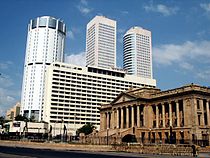
Government Geography Buildings and
landmarksHistoricalParks and GardensCulture Sports SSC Stadium · R. Premadasa Stadium · Colombo Cricket Club · Royal Colombo Golf Club · Colombo Sports ClubsEducation University of Colombo · Royal College Colombo · Colombo Medical College · Colombo Law College · List of schools in ColomboCategories:- Royal College Colombo
- Royal Colleges
- Educational institutions established in 1835
- Schools in Colombo
- National schools in Sri Lanka
- Public schools in Sri Lanka
- Boys' schools in Sri Lanka
- Boarding schools in Sri Lanka
- Schools with a Cadet Corps
- Colombo
- Buildings and structures in Colombo
- Academic institutions formerly affiliated with the University of Calcutta
Wikimedia Foundation. 2010.

